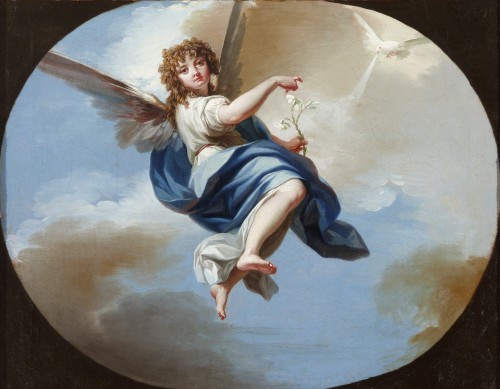Spanish Old Master Paintings
Saint Gabriel the Archangel
Zacarías González Velázquez
(Madrid, 1763-1834)
- Oil on canvas
- 35 x 45 cm
- Sold to the Museo de Historia de Madrid, 2020
In the mid-17th century, a small oratory dedicated to Jacobo Gratij, Knight of the Order of Christ and Apostolic Nuncio of Pope Gregory XIII to the court of Philip II of Spain, was erected in the center of Madrid, according to the measurements of Juan de Torija, the first surveyor of royal works. Nuncio Jacobo Gratij had settled in Madrid, been ordained a priest, and bequeathed his fortune to the foundation of the Royal, Ancient and Venerable Congregation of the Unworthy Slaves of the Most Blessed Sacrament, whose mission was to spread Eucharistic worship. A century later, the building, known as the Royal Oratory of the Knight of Grace, no longer met the needs of the Congregation. Its reconstruction was decided during the reign of Charles III and work began in 1782, under the direction of Juan de Villanueva, the first architect of royal works. Villanueva, who was commissioned for the first time on a religious project, himself recommended that the tempera paintings on the dome be entrusted to the painter Zacarías González Velázquez, then the most renowned painter at court. Zacarías had trained with Mariano Salvador Maella, his brother-in-law, before entering the Academy of Fine Arts of San Fernando in Madrid in 1777. His father, Antonio González Velázquez, also a painter, was its director. After his years of apprenticeship, he was appointed Academician of San Fernando in 1790, an institution he then directed from 1828 to 1831. The artist worked for the court, executing frescoes for various royal sites such as the Pardo Palace and the Casa del Labrador residence in Aranjuez. At the same time, he received commissions for religious works throughout the country. He thus produced works for the oratory of the Santa Grotto in Cadiz (with Goya), the cathedral of Toledo, the cloister of the Basilica of San Francisco el Grande in Madrid, the tabernacle of the cathedral of Jaén, as well as several canvases and mural decorations for the Royal Oratory of the Knight of Grace in Madrid, the work to which we refer here. For the latter, and in accordance with the available documentation, Zacarías had received instructions directly from the Congregation regarding the themes to be executed that would adorn the half-orange vault, the skylight and the pendentives. To decorate the triangular spaces of the four pendentives, it was agreed that the figures of “Saint Michael, Saint Gabriel, Saint Raphael and the Holy Guardian Angel” would be painted. Before work on the dome began (we know that it had already begun on March 28, 1792), Zacarías González Velázquez probably had to submit sketches of the paintings he was going to make to the Congregation for approval. Some of these oil on canvas sketches are preserved, such as those depicting the Old Testament passages that mention the sacrament of the Eucharist, preserved in the Peralada Castle Museum in Catalonia. Also preserved are the four pendants, works that we present here, which remained in the possession of their author until his death in 1834, as evidenced by the inventory of the assets of his testamentary succession. The document in question states: “145. Four sketches of the four Archangels that appear on the pendentives of the church of the Knight of Grace, one foot and six inches long and one foot and three inches high, with a value of four hundred reales… 400. The works were awarded to his daughter Clara González Velázquez, as indicated in the document certifying her share of the inheritance. The four canvases depict, within oval shapes, the flying figures of the Archangels and the Guardian Angel, each with an attribute that helps identify them. Thus, Saint Michael is depicted crushing a serpent that symbolizes Evil. Saint Gabriel holds lilies in his hands and points towards the dove of the Holy Spirit, two emblems of the Annunciation. Saint Raphael holds a fish. As for the Guardian Angel, he carries a child in his arms, whom he protects. The colours, elegance, and movement of the figures make these works among the best of Zacarías González Velázquez’s production and references in Spanish neoclassical painting. They are all the more important since the tempera paintings made by the artist on the pendentives of the oratory have not been preserved. Severely damaged by humidity, they were chipped away down to the mortar layer during the restoration work on the building that took place between 1975 and 1979 and were irretrievably lost. Following this, they were replaced with a decoration that included garland motifs and the Congregation’s coat of arms, and then restored, like the rest of the dome, in 2002. However, after locating the sketches that we present here, and also thanks to old photographs, it was decided in 2010 to recreate the original paintings on canvas and place them on the pendentives. The artist’s sketches have once again contributed to shedding light on a part of the history of the Oratory of the Knight of Grace, one of the great jewels of Madrid’s neoclassicism, which has also been able to regain its original appearance.


